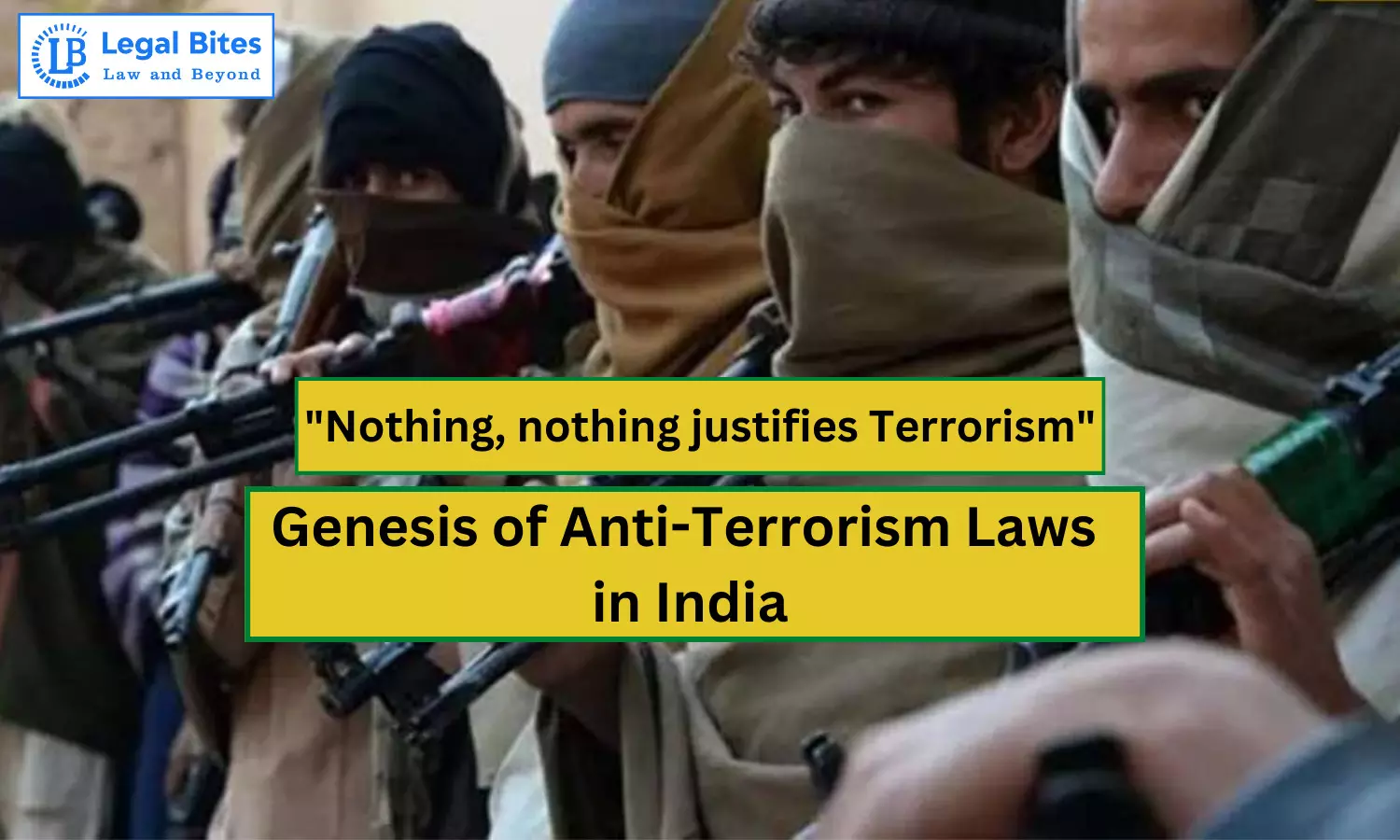Genesis of Anti-Terrorism Laws in India
The article 'Genesis of Anti-Terrorism Laws in India' demonstrates the meaning of terrorism, laws against terrorism, and the major incidents of terrorist acts that took place in India, causing a tremendous loss of life.

The article 'Genesis of Anti-Terrorism Laws in India' demonstrates the meaning of terrorism, laws against terrorism, and the major incidents of terrorist acts that took place in India, causing a tremendous loss of life.
Introduction
Terrorism is generally used for bomb blasts, invasion of a place with guns, hijacking of railways, planes, etc., just for one motive – to kill as many people as possible. Terrorists think of themselves as barbaric while causing such kind of inhumanity, they consider themselves to be insurgents or messiahs of God (Allah), who were sent to earth to punish the infidel. Terrorists are often trained by terrorist organizations by brainwashing them and turning them into inhuman creatures. Cross- Border terrorism upsurged a lot in the years from the 1990s to 2011. After that, the 26/11 incident turned out to be a real eye-opener for the authorities.[1]
The general laws, such as the Code of Criminal Procedure, 1973, and the Indian Penal Code, 1860, were not apt to deal with such mass killings. Therefore, the various legislations discussed below had to be enacted to counter terrorism.
What is terrorism?
Terrorism is defined under section 15 of the Prevention of Unlawful Activities Act, 1967 as
"Whoever does any act with intent to threaten or likely to threaten the unity, integrity, security [economic security,] or sovereignty of India or with intent to strike terror or likely to strike terror in the people or any section of the people in India or in any foreign country."
By using:
1. dynamite or other explosive substances
2. inflammable substances
3. firearms
4. other lethal weapons
5. poisonous or noxious gases
6. other chemicals
7. by any other substances (whether biological, radioactive, nuclear or any other) of a hazardous nature or by any other means of whatever nature to cause or likely to cause.
Any of which is likely to cause death or injury to any person, destruction/damage of any property/monetary stability of India (by smuggling/ circulation of Indian currency, coin, or any other material), disruption of essential supplies/services for the survival of life of a community, overawes by the use of criminal force attempts or causes the death of public functionary, detains/ kidnaps/abducts/threaten to kill/injure to compel the government of India/ any state/ foreign country/ international organization/ intergovernmental organization.
Pre-independence terrorism
Prior to independence, terrorism was a form of revolt against the British by Indian freedom fighters. That was not done to harm the general public or the Britishers but only to cause damage to property. On 8th April 1929, Bhagat Singh, and Batukeshwar Dutt, threw two bombs into the Assembly chamber from its public gallery while it was in session. Those bombs were not designed nor intended to kill; however, a few members got injured, including George Ernest Schuster, the then-finance member of the Viceroy's Executive Council.
Major Incident of Terrorist Attack in India
- On 12th March 1993, the Bombay bombings incident occurred, which was a series of 12 terrorist bombings in Bombay, Maharashtra. The single-day attacks resulted in 257 deaths and left 1,400 injured people.
- On 30th December 1996 Brahmaputra Express Train bombing took place, this derailed the rain and killed a minimum of 33 people.
- In May and July 2000, the Church Bombings incident took place, these included a Christian congregation at Machilipatnam, Jewett Memorial Baptist Church in Ongole, and, the Mother Vannini Catholic Church in Tadepalligudem town, all in Andhra Pradesh.
- On 21st December 2002 Kurnool train crash took place, it was a deliberate derailment and crash of a passenger train in Kurnool, Andhra Pradesh. Syed Abdul Nayeem, a Lashkar-e-Taiba terrorist, was charged with this, and another bombing that killed 2 people at Sai Baba Temple.
- On 15th August 2004, Dhemaji school bombing incident occurred at Dhemaji College ground, killing at least 18 and injuring many more.
- On 21st May 1996, the Lajpat Nagar Market Blast incident took place, killing 13 civilians and injuring 39, a day later the 1996 Dausa blast occurred, killing 14 and injuring 37.
- In 2000 a terrorist attack incident on Red Fort took place, killing two soldiers and one civilian.
- On 13th December 2001, an attack on the Indian parliament occurred, involving a 45-minute gun battle, 9 policemen and parliament staff were killed. The terrorists used AK-47 rifles, explosives, and grenades.
- On 25th August 2003 – Two Bombs near the Gateway of India and Zaveri Bazaar, killed 50.
- On 29th October 2005, the Delhi Bombings incident occurred:
i) The first blast - main bazaar of Paharganj near the New Delhi Railway Station at 5:38 pm
ii) The second blast took – a bus in Govindpuri, Delhi area at 6:00 pm.
iii) The Third explosion – Sarojini Nagar market, New Delhi at 6:05 pm.
- On 13th September 2008 – a series of five attacks took place, it killed around 30 people and injured a minimum of 90.
- From 26th November 2008 to 29 November 2008 – Coordinated a series of attacks on Taj Hotels, which killed 172.
- On 7th September 2011, a bomb was planted outside the Delhi High Court, killing 15 and injuring 79.
- On 11th July 2006 – Seven train bombs were planted that killed 209 people.
Evolution of India's Anti-Terrorism Law
The Unlawful Activities (Prevention) Act, 1967 and the National Securities Act, 1980 are the primary legislations mandated to deal with terrorist activities in India. In the Unlawful Activities (Prevention) Act, 1967 the chapter for prosecuting terrorists was introduced in 2004. Before this, the Terrorist and Disruptive Activities (Prevention) Act of 1987 (TADA), Prevention of Terrorism Act of 2002 (POTA) were the first-hand legislations that dealt with terrorist activities. Both legislations provided for a minimum of 3 or 5 years of imprisonment, which can be extended to life imprisonment under section 3. Out of these two, the prior legislation has a provision under section 4 of disruptive activities.
It also says that the investigation officer can seize/ attach the property related to terrorist means with the approval of the superintendent of police, whereas the later Act does that with the approval of the Director General of Police. The latter also has a section (section 6) related to the proceeds of terrorism that shall be declared illegal. Also, under the latter, a person accused cannot be granted bail unless the Public Prosecutor is heard and the court has a reason to believe that he is not guilty of the offence. However, both acts were later repealed in 1987 and 2004 respectively.
Maharashtra Control of Organised Crime Act, 1999 (MCOCA) is a state legislature in the state of Maharashtra to tackle terrorism. As Mumbai is a highly populated and sea-touching city, it has a high number of terrorist attacks, the legislation was the need of the hour. The Act classifies the promotion of insurrections as a terrorist act. Bail under the Act can only be granted by the court when the Public Prosecutor has been heard and the court has the reason to believe that he is not guilty of the offence and he will not commit any offence on bail.
The Unlawful Activities (Prevention) Act, 1967 though in force from 1967, had an impact on legislation on terrorist activities from 2004 onwards.[2] The Punishment for the terrorist act is either death or life imprisonment under the act. A non-citizen accused cannot be granted bail except under some exceptional circumstances, and those reasons should be written down by the court.
Is there any controversy regarding anti-terrorism laws?
Terrorism often takes a religious angle, the reason being most of the terrorists belong to one single religion, and they say that they do it for God. However, they are fed that mindset by someone else, even for political purposes, e.g. Taliban took over Afghanistan. However, religion is not responsible for a terrorist act, but people bend the rules of religion for various reasons.
Case Laws
In the case of Kartar Singh v. State of Punjab[3], the Supreme Court of India maintained its constitutional legitimacy on the presumption that individuals given such draconian statutory powers would act in good faith and for the benefit of the public.
In the case of Mohd. Ajmal Amir Kasab v. State of Maharashtra[4], it was held that a Terrorist Act under Section 15, held, does not automatically fall outside the umbrage of Section 121 IPC.
In the case of Indra Das v. State of Assam[5], it was held that section 3(5) of TADA or Section 10 of the Unlawful Activities (Prevention) Act, 1967 which on plain language makes mere membership of a banned organization criminal, has to be read down so as not to violate Articles 19 and 21 of the Constitution.
In the case of Redaul Hussain Khan v. National Investigation Agency[6], it was held that merely because the organization concerned had not been declared an "unlawful association" when the petitioner was arrested, does not mean that the said organization could not have indulged in terrorist acts or that the petitioner could not have had knowledge of such activities.
In the case of Jamaat-E-Islami Hind v. Union of India[7], the definitions of 'unlawful activity' and 'unlawful association' under clauses (f) and (g) of Section 2 of the Act were made clear, and the determination of the question of whether any association is or has become, an unlawful association to justify a declaration under Section 3(1) should be that "any action taken" by such association constitutes an "unlawful activity" which is the object of the association or the object is any activity punishable under Section 153-A or Section 153-B IPC.
In the case of Extra Judicial Execution Victim Families Assn. v. Union of India[8], it was held that there is no room left for doubt that certain organizations in Manipur (listed herein) are not only terrorist organizations and gangs but also unlawful associations
Conclusion
It can be concluded that there has been a decline in religious terrorism by 82% in 2021, but political terrorism has surged up.[9] For example the killing of Sidhu Moosewala, there is strong nexus between the terrorist group of gangsters who killed him, followed by the 2 killings (Raju Theth) in Sikar, Rajasthan, claimed by the same group.[10]
Laws in India to counter terrorism have only become stronger day by day. The approach is right in preventing terrorism, many bombs get diffused in time by the agencies, however, after conviction, it might take years to hang the terrorist.
References
[1] Anti-terrorism laws in India: Distinguishing Myth & Reality, Available Here
[2] Evolution of India's Anti-Terrorism Law, Available Here
[3] (1994) 3 SCC 569
[4] (2012) 9 SCC 1: (2012) 3 SCC (Cri) 481
[5] (2011) 3 SCC 380: (2011) 1 SCC (Cri) 1150
[6] (2010) 1 SCC 521: (2010) 1 SCC (Cri) 822
[7] (1995) 1 SCC 428
[8] (2016) 14 SCC 536: (2016) 4 SCC (Cri) 508
[9] Global Terrorism Index 2022, Available Here
[10] Sidhu Moose Wala murder: Strong nexus between terror groups, murder accused, says Punjab DGP, Available Here
Important Links
Law Library: Notes and Study Material for LLB, LLM, Judiciary, and Entrance Exams

